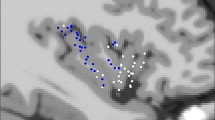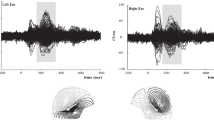Abstract
Following monoaural stimulation, long latency auditory evoked potentials (LLAEPs) recorded from contralateral temporal areas have a shorter latency and larger amplitude than those recorded from the ipsilateral temporal areas. This observation agrees with the operational model drawn up in 1967 by Kimura, which assumes that only anatomically prevailing crossed auditory pathways are active during dichotic hearing, while direct pathways are inhibited. The inputs may then be conveyed to the contralateral cortex, from where they finally reach the ipsilateral temporal areas by means of interhemispheric commissures. It is this mechanism which may underline the right ear advantage for verbal stimuli and the left ear advantage for melodies observed when administering dichotic listening tasks. With the aim of verifying this hypothesis, we recorded temporal LLAEPs in a 21 year-old woman suffering from complex partial seizures, whose CT scan and MRI showed corpus callosum agenesia. Our data support the hypothesis that ipsilateral pathways are greatly inhibited by the contralateral pathways, and therefore auditory stimuli can be supposed to reach the contralateral auditory cortex from where they are transferred through the corpus callosum to the ipsilateral auditory cortex.
Sommario
I potenziali evocati acustici a lunga latenza (PEALL) registrati dalle regioni dello scalpo controlaterali al lato stimolato presentano minor latenza e maggiore ampiezza di quelli registrati omolateralmente, in accordo con il modello operazionale proposto nel 1967 dalla Kimura, in base al quale soltanto le vie acustiche crociate sarebbero attive durante l'ascolto dicotico, mentre le vie dirette sarebbero inibite. Lo stimolo acustico dunque raggiungerebbe la corteccia controlaterale e da qui, tramite il corpo calloso, verrebbe inviato nell'area acustica omolaterale. Ciò spiegherebbe perché l'orecchio destro fornisce migliori prestazioni nel riconoscimento di stimoli verbali e quello sinistro nel riconoscimento di sequenze musicali. Nel presente lavoro abbiamo registrato i PEALL in una giovane di 21 anni affetta da epilessia parziale complessa e agenesia del corpo calloso, al fine di verificare tale ipotesi. I nostri risultati sembrano confermare l'ipotesi della Kimura secondo la quale la via acustica ipsilaterale risulta inibita dalla via controlaterale. Lo stimolo acustico raggiungerebbe pertanto la corteccia uditiva controlaterale, donde verrebbe successivamente trasferlto tramite il corpo calloso alla corteccia uditiva ipsilaterale.
Similar content being viewed by others
References
Adrian H.O., Lifschitz W.M., Tavitas R.J., Galli F.P.:Activity of neural unit in medial geniculate body of the cat and the rabbit. J. Neurophysiol. 29:1046–1060, 1966.
Aiello I., Sau G.F., Sotgiu S., Manca S., Rosati G.:Long latency auditory evoked potentials: normative data. It. J. Clin. Neurophysiol. 1:15–23, 1992.
Alexander M.P., Warren R.L.:Localization of callosal auditory pathways: a CT case study. Neurology 38:802–804, 1988.
Connolly J.F.:Stability of pathway-hemisphere differences in the auditory event related potentials (ERP) for monoaural stimulation. Psychophysiology 22:87–95, 1985.
Cracco R.Q., Amassian V.E., Maccabee P.J., Cracco J.B.:Comparison of human transcallosal responses evoked by magnetic coil and electrical stimulation. Electroencephalogr. Clin. Neurophysiol. 74(6):417–424, 1989.
Damasio H., Damasio A.:“Paradoxic” ear extinction in dichotic listening: possible anatomic significance. Neurology, 29:644–653, 1979.
Efron R., Bogen J.E., Yund E.W.:Perception of dichotic chords by normal and commissurotomized human subjects. Cortex 13:137–148, 1977.
Geffen G.:Phonological fusion after partial section of the corpus callosum. Neuropsychologia, 18:613–620, 1980.
Holtzman J.D., Sidtis J.J., Volpe B.T., Wilson D.H., Gazzaniga M.S.:Dissociation of spatial information for stimulus localization and the control of attention. Brain 104:861–872, 1981.
Kimura D.:Some effects of temporal lobe damage on auditory perception. Can. J. Psychol. 15:157–165, 1961.
Kimura D.:Functional asymmetry of the brain in dichotic listening. Cortex 3:163–168, 1967.
Kooi K.A., Tipton A.C., Marshall R.E.:Polarities and field configurations of the vertex components of the human auditory evoked response: a reinterpretation. Electroencephalogr. Clin. Neurophysiol. 31:166–169, 1971.
MacKay D.M., MacKay V.:Explicit dialogue between left and right half-systems of split brains. Nature 295:690–691, 1982.
Milner B., Taylor S., Sperry R.:Lateralized suppression of dichotically presented digits after commissural section in man. Science, 161:184–185, 1968.
Mononen L.J., Seitz M.R.:An AER analysis of contralateral advantage in the transmission of auditory information. Neuropsychologia, 15:165–173, 1976.
Musiek F.E., Reeves A.G., Baran J.A.:Release for central auditory competition in the split-brain patient. Neurology, 35:983–987, 1985.
Pandya D.N., Hallett M., Mukhergee S.K.:Intra- and interhemispheric connections of the neocortical auditory system in the rhesus monkey. Brain Res. 14:49–65, 1969.
Pellettier J., Habib M., Brouchon M., et al.:Etude du transfert interhémisphérique dans la sclérose en plaques. Corrélations morpho-fonctionelles. Rev. Neurol. (Paris) 148: 11, 672–697, 1992.
Pickles J.O.:An introduction to the Physiology of Hearing. New York: Academic Press, 1982.
Rosenzweig M.R.:Representation of the two ears at the auditory cortex. Amer. J. Physiol. 167:147–158, 1951.
Sergent J.:Unified response to bilateral hemispheric stimulation by a split-brain patient. Nature 305:800–802, 1983.
Sidtis J.J., Volpe B.T., Holtzman J.D., et al.:Cognitive interaction after staged callosal section: evidence for transfer of semantic activation. Science 212:344–346, 1981a.
Sidtis J.J.:Dichotic listening after commissurotomy in: K. Hugdahl (Ed.). Handbook of Dichotic Listening: Theory, Methods and Research. J. Wiley & Sons Ltd, pp. 161, 1988.
Sparks R., Geschwind N.:Dichotic listening in man after section of neocortical commissures. Cortex 4:3–16, 1968.
Springer S.P., Gazzaniga M.S.:Dichotic testing of partial and complete split-brain subjects. Neuropsychologia 13:341–346, 1975.
Trevarthen C.:Hemispheric Disconnection and Cerebral Functions (ed. Kinsbourne M. and Smith W.), Thomas, Springfield, 1974.
Wolpaw J.R., Penry J.K.:A temporal component of the auditory evoked response. Electroencephalogr. Clin. Neurophysiol. 39:609–620, 1975.
Wolpaw J.R., Penry J.K.:Hemispheric differences in the auditory evoked response. Electroencephalogr. Clin. Neurophysiol. 43:99–102, 1977.
Author information
Authors and Affiliations
Additional information
This work was supported by a grant from the Italian Ministry of Education (ministero della Pubblica Istruzione).
Rights and permissions
About this article
Cite this article
Aiello, I., Sotgiu, S., Sau, G.F. et al. Long latency evoked potentials in a case of corpus callosum agenesia. Ital J Neuro Sci 15, 497–505 (1994). https://doi.org/10.1007/BF02334611
Received:
Accepted:
Issue Date:
DOI: https://doi.org/10.1007/BF02334611




